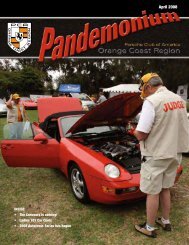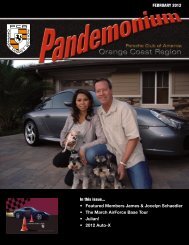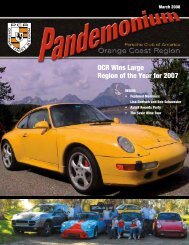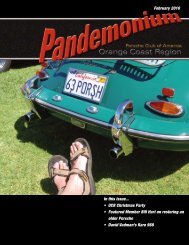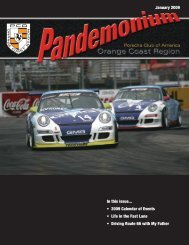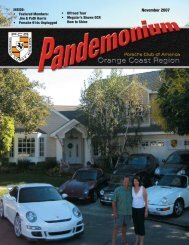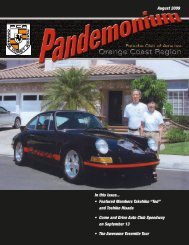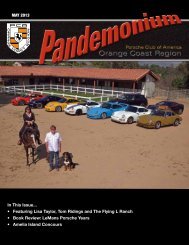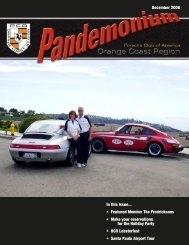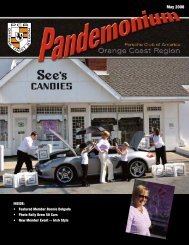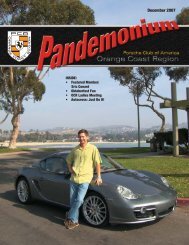JANUARY 2013 In This Issue... Toys 4 Tots Paso Robles Wine Tour ...
JANUARY 2013 In This Issue... Toys 4 Tots Paso Robles Wine Tour ...
JANUARY 2013 In This Issue... Toys 4 Tots Paso Robles Wine Tour ...
Create successful ePaper yourself
Turn your PDF publications into a flip-book with our unique Google optimized e-Paper software.
Rice’s Ramblings:<br />
Elusive Surging Ignition-Again<br />
1973 911 Carrera Impressions<br />
Story by Lee Rice<br />
The New Year is here with a New Hope<br />
for an improving outlook for everyone.<br />
911 ignition problems:<br />
Question: My 1982 911SC had some<br />
work done a while ago… and I notice<br />
my SC wants to accelerate and then as<br />
suddenly decelerate, only slightly all<br />
in a cycle lasting 1-2 seconds. Is there<br />
something I can do for this?<br />
Reply: The 911SC is particularly<br />
sensitive to ignition timing. Even slight<br />
mis-timing can result in surges, like what<br />
you are experiencing. The specifications<br />
for the 1982 are within the 1980 thru 1983<br />
SC Specifications. The timing must be<br />
checked at 950+ 50 rpm, with the red and<br />
blue vacuum hoses pulled off the ignition<br />
distributor’s “double vacuum box”. Next<br />
adjust the ignition timing to 5 degrees<br />
BTDC while maintaining 950 rpm. Then<br />
re-install the red and blue vacuum hoses.<br />
To check the “vacuum box” *<br />
(930.602.915.01) BOSCH: 1 237 122<br />
736 (See image # 1) Note* The RED<br />
hose provides vacuum for advance at<br />
cruise power. The BLUE hose provides<br />
vacuum for idle retard.*<br />
1. Check VACUUM RETARD: with<br />
blue hose connected, disconnect the<br />
red hose at the vacuum box’s front<br />
connection #2. Ignition timing must<br />
be between -3’and -7’ ATDC.<br />
2. Check VACUUM ADVANCE:<br />
Disconnect blue hose from<br />
connection #1, and disconnect red<br />
hoses from connection #2. Now<br />
connect blue hose to connection<br />
#2. Adjust idle speed to 950 +50<br />
rpm. -Ignition timing must be<br />
between 8’ to 12’ BTDC.<br />
3. Re- install red hose to #2 and blue<br />
hose to #1, adjust idle speed to 950<br />
+50 rpm<br />
These specification are found in<br />
Werk Shop Manual 1972 onward section<br />
9.3 – 2/13<br />
Anniversary<br />
<strong>2013</strong> is also an anniversary for us Porsche<br />
911 fanatics of old, as we recollect back 40<br />
years ago, history was about to unfold in<br />
an amazing and dramatic way. These 911<br />
cars we admire so much and just cannot<br />
seem to get enough of, were originally<br />
destined to build in a production life of<br />
about 5- 7 years. The 911 was, after all,<br />
an intended move-up from the 4 cylinder<br />
“putt-putt” image of Porsche. <strong>This</strong> is no<br />
put down either. The evolution of the 4<br />
cylinder Porsche came about in the early<br />
1930s and its history is a marvel from<br />
Ferdinand Porsche himself.<br />
<strong>In</strong> the 1960s Ferry Porsche and his<br />
sons wanted to make their own history<br />
with a new Porsche. A new design<br />
was the answer with a growing West<br />
Germany economy and a world market.<br />
<strong>This</strong> required an entirely new design<br />
with much more power, higher speed,<br />
more driver-passenger room and modern<br />
amenities. The 356 had evolved to its limit<br />
and then (1961) a more modern car was<br />
needed. <strong>This</strong> gave birth to Werk Design<br />
Nr. 901, then a new name: “911.”<br />
1973 was the arrival of a new upgraded<br />
version of the 911, which became<br />
a prominent racing car called the Carrera<br />
Renn Sport Rennen. A German way to<br />
state: Ralley/Sporting/Racing. Porsche<br />
was determined to reduce any weight<br />
not absolutely necessary by making the<br />
# 1 -SC ignition timing layout<br />
new 911 as lightweight as possible and<br />
still have a street/road drivable 911. <strong>This</strong><br />
gave birth to Porsche’s “less is more”<br />
philosophy. However, Porsche had to<br />
sell 500 basic examples of the RSR to be<br />
classified for homologation purposes that<br />
was the: “Carrera RS.” The RS enabled<br />
Porsche to be eligible to race in the Group<br />
4 Special GT Class. These were called<br />
the 911 2.7 Carrera RS, which became<br />
the basis for the full blown 2.8 Liter, all<br />
out racing, 2.8 Carrera RSR.<br />
From a long time ago I recall my<br />
first impression of the 2.7 Carrera RS, it<br />
was on my wedding day, June 16 1973.<br />
I had my 1968 911 perfectly polished<br />
and ready to gently speed my bride and<br />
myself from church –the very same car<br />
and same bride I have today. Thank<br />
You!<br />
Anyway, just before leaving for<br />
church the mailman delivered my<br />
Competition Press/ Autoweek and on the<br />
first page I saw, hot off the press from the<br />
Paris Auto Show, a pictured 911, in white<br />
with a blue “Carrera” stripe, blue centered<br />
Fuchs wheels and that famous ‘duck tail.’<br />
I was stunned! I was determined to have<br />
one someday, or in my case build one!<br />
SEE image # 2 (<strong>This</strong> has a familiar feel<br />
- like what is brewing for <strong>2013</strong> and 2014:<br />
the arrival of the Porsche 918) And with<br />
that in mind I asked my brother John<br />
Rice, to tell me his first impression of his<br />
first 1973 911 2.7 Carrera RS.<br />
“…Lee and I were due to meet in<br />
Monterey for a visit and Lee went out<br />
(Continued on Page 23)<br />
<strong>JANUARY</strong> <strong>2013</strong> 15



